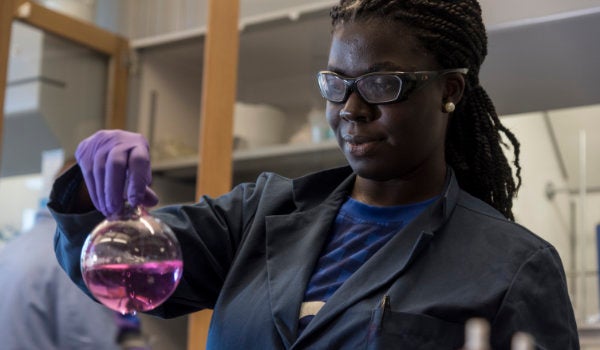It all started as a hobby. In an attempt to get some time away from his career as an Associate Professor of Chemistry at URI with a focus on catalyst development, Dr. Matthew Kiesewetter took up beekeeping in his spare time. His views on taking time away from chemistry quickly changed, however, after he discovered a certain responsibility modern beekeepers have had to take on: managing varroa mites. But what exactly are these mites? “Varroa mites are a parasite of the honeybee that have been implicated in colony collapse disorder, or the disappearance or decline of honeybee populations,” Kiesewetter says, “You treat varroa mites with one of a handful of organic compounds. One of the problems facing beekeepers is that the mites are showing resistance to some of these compounds; some have lost their efficacy entirely.”
It was then that Kiesewetter was able to put his knowledge of organic chemistry into practice. “When faced with this problem in medicinal chemistry,” he says, “it is common practice to change the molecule in some way – add a methyl group, a fluoride, change an aromatic ring, something to circumvent resistance and hopefully restore the efficacy of a drug.” This concept is a familiar one when it comes to studying antibiotic resistance, as Kiesewetter points out that “medicinal chemists have been fighting this problem for decades by changing penicillins on a molecular level.” Kiesewetter in turn took this information and applied it to managing the mites. He turned his curiosity into fuel for research, discovering that action could be taken from an organic chemistry standpoint. “As someone who has traditionally focused on more fundamental research,” he says, “it was very exciting to think that I could make a difference in a global problem of wide awareness. One of my graduate students jumped at the chance to get involved and we were off to the races.”
And off they went, attempting to discern new methods and materials for managing varroa mites by working with the honeybee populations at URI’s East Farm. “You can manage varroa populations with one of several organic compounds,” Kiesewetter explains, “However, many of these compounds are losing effectiveness at managing varroa.” The challenge, then, was creating new compounds and new methods of delivery. “This involves organic synthesis in the chemistry lab — that is my group’s part — and field testing on live honeybees — that is my collaborator’s part,” he says. The plans for the experiments were in motion, and yet Kiesewetter and his colleagues struggled to get past square one. Amidst the chaos this year of setting up hives and ordering bees, the clock was ticking on testing the compounds. Soon enough, they were able to test the first compound and move onto their control subjects. It was then that they began recording observations. “What is the mite mortality/elimination? Good. What is the bee mortality? Low. Is this chemical easy to handle? Readily,” he says. “The more we looked, the more promising things became. Now we are scaling up our experiments to whole hives and finishing our studies.”
With all the hard work he has put in, however, Kiesewetter has come to realize that there’s a lot more to studying honeybees than meets the eye. Treating the pollinators can be harsh on them, as well as sometimes yielding inconsistent results. Despite these impediments, Kiesewetter is confident that they’re closer than ever to finding a solution. “So far, our leading compound, which my group has used in the past as a polymer building block, looks to circumvent a lot of these problems,” he explains, “It looks like it is fairly gentle on the bees, it is non-toxic and fully biodegradable and very easy to handle. Other treatments are corrosive acids, and ours in theory is edible.”
While the study remains unpublished for the time being, as they’re currently seeking to patent their results after the approval of an intellectual property disclosure, Kiesewetter sees this as the dawn of a greater research project for himself and his colleagues, with new ideas waiting to be put to the test. As for the university that helped him get this far, he has plenty of praise for the assistance URI has provided on all academic levels. He credits in particular Professor Steve Alm from the Department of Entomology as the driving force behind the project. “His expertise has facilitated a level of progress that I had not thought we could achieve in a few short months,” Kiesewetter says. As for the essence of interdisciplinary research, he points to the unexpected joy of working with others from different, seemingly unrelated fields who are interested in pooling resources to reach the same end goal: “This has been a lot of fun for me,” Kiesewetter says, “because their lab looks a lot different than mine. They do their experiments in a field, mine are in a fume hood.” And the different, seemingly unrelated connections don’t stop there: Kiesewetter has even received help from another passionate beekeeper, URI’s Vice President for Research and Economic Development Peter Snyder, who has been more than willing to help with Kiesewetter’s efforts. “Some of this is ‘right people, right time’ kind of luck,” he explains, “But I remain awestruck at the level of support and amount of progress that we have made.”
~Written by Chase Hoffman, Writing & Rhetoric and Anthropology Double Major, URI Class of 2021



